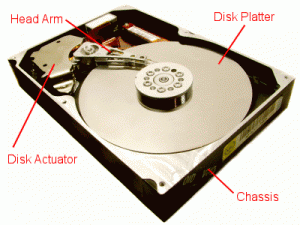What is a Hard Drive? | How Do Hard Drives Work?
 A hard drive is a hardware device within a computer or external chassis that spins (a solid state drive does not spin, and is an altogether different technology) a magnetic disk that reads and writes information to and from it. The illustration on this page show the internal parts of a hard drive. This is a typical illustration, while most hard drives work identically, they may vary a bit in style and looks.
A hard drive is a hardware device within a computer or external chassis that spins (a solid state drive does not spin, and is an altogether different technology) a magnetic disk that reads and writes information to and from it. The illustration on this page show the internal parts of a hard drive. This is a typical illustration, while most hard drives work identically, they may vary a bit in style and looks.
Hard drives are not typically accessed by the user physically and are normally internal to the computer case. The only exception today, is that if one were to use an external hard drive to carry from place to place or for backup purposes. External hard drives that are used for portable storage are usually in an enclosed casing.
In the illustration on this page, you will see that the four main parts of a hard drive are the disk platters, head arm, disk actuator, and the chassis. Not much has changed in the thought of how a hard drive works from it’s early days of conception, albeit the size of the drive has been standardized to both desktop and mobile sizes. The density of how much can be written on the platters have changed tremendously as well over time. I personally remember a 1mb hard drive out of an old IBM word processor with a 8086 cpu. It was state of the art back then. As new technologies are explored, someday even this style will change as barriers of physical and mechanical impossibilities become possible.
What is not shown in the picture is the connectors and circuit board below. Since the introduction of the SATA connector & power connector, the old school IDE & SCSI connection types have since faded into the past. No doubt someday, even SATA will become obsolete.




